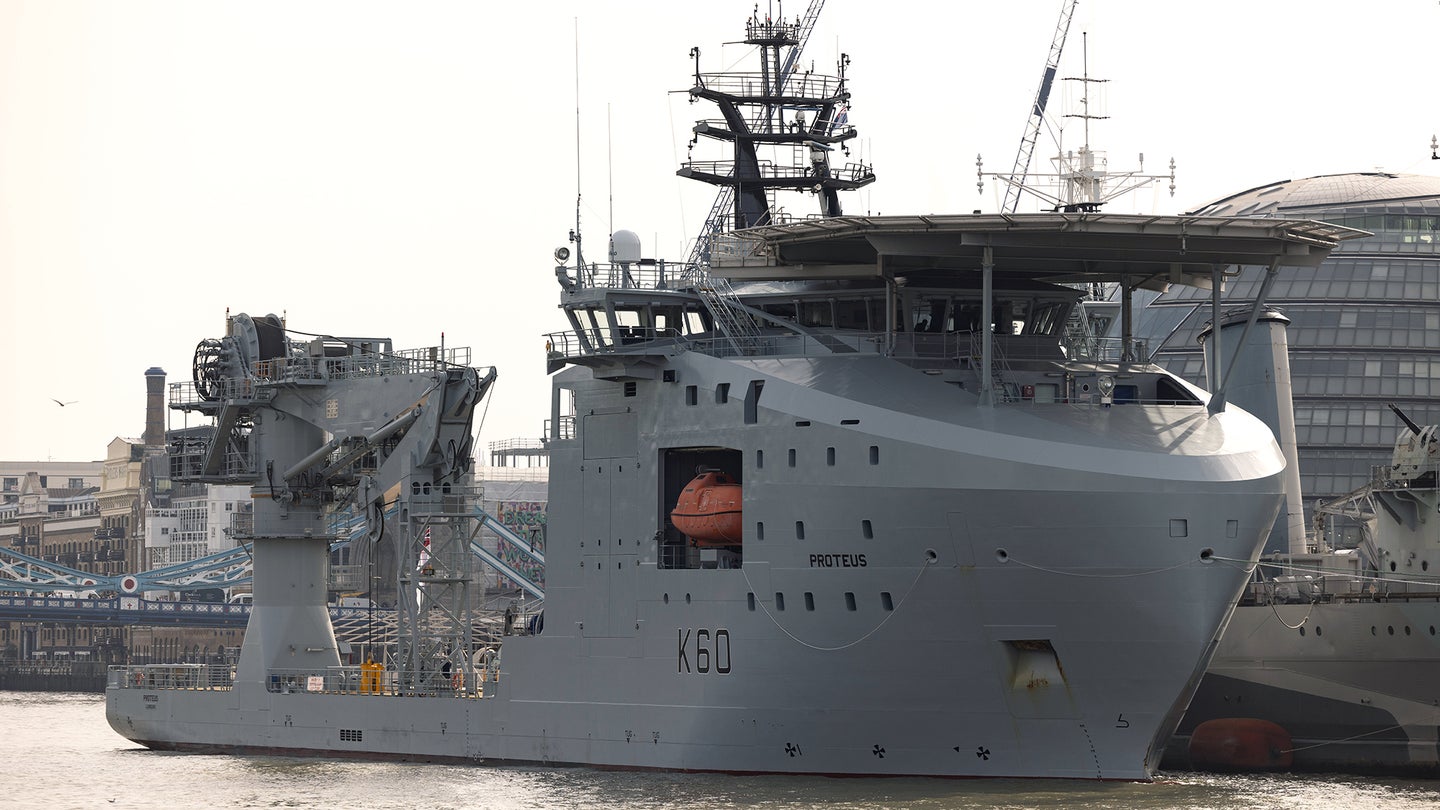This weird-looking British ship will keep an eye out for sabotage beneath the surface
It's called the Proteus, and it's a surveillance vessel.

On October 10, the Royal Fleet Auxiliary dedicated a ship called the Proteus in a ceremony on the River Thames. The vessel, which looks like someone started building a ship and then stopped halfway through, is the first in the fleet’s Multi-Role Ocean Surveillance program, and is a conversion from a civilian vessel.
In its new role, the Proteus will keep a protective eye on underwater infrastructure deemed vitally important, and will command underwater robots as part of that task. Before being converted to military use, the RFA Proteus was the Norwegian-built MV Topaz Tangaroa, and it was used to support oil platforms.
Underwater infrastructure, especially pipelines and communications cables, make the United Kingdom inextricably connected to the world around it. While these structures are hard to get to, as they rest on the seafloor, they are not impossible to reach. Commercial vessels, like the oil rig tenders the Proteus was adapted from, can reach below the surface with cranes and see below it through remotely operated submarines. Dedicated military submarines can also access seafloor cables. By keeping an eye on underwater infrastructure, the Proteus increases the chance that saboteurs can be caught, and more importantly, improves the odds that damage can be found and repaired quickly.
“Proteus will serve as a testbed for advancing science and technological development enabling the UK to maintain the competitive edge beneath the waves,” reads the Royal Navy’s announcement of the ship’s dedication.
The time between purchase and dedication of the Topaz Tangaroa to the Proteus was just 11 months, with conversion completed in September. The 6,600-ton vessel is operated by a crew of just 26 from the Royal Fleet Auxiliary, while the surveillance, survey, and warfare systems on the Proteus are crewed by 60 specialists from the Royal Navy. As the Topaz Tangaroa, the vessel was equipped for subsea construction, installation, light maintenance, and inspection work, as well as survey and remotely operated vehicle operations. The Proteus retains its forward-mounted helipad, which looks like a hexagonal brim worn above the bow of the ship.
Most striking about the Proteus is the large and flat rear deck, which features a massive crane as well as 10,700 square feet of working space, which is as much as five tennis courts. Helpful to the ship’s role as a home base for robot submersibles is a covered “moon pool” in the deck that, whenever uncovered, lets the ship launch submarines directly beneath it into the ocean.
“This is an entirely new mission for the Royal Fleet Auxiliary – and one we relish,” Commodore David Eagles RFA, the head of the Royal Fleet Auxiliary, said upon announcement of the vessel in January.
Proteus is named for one of the sons of the sea god Poseidon in Greek mythology, with Proteus having domain over rivers and the changing nature of the sea. While dedicated on a river, the ship is designed for deep-sea operation, with a ballast system providing stability as it works in the high seas.
“Primarily for reasons of operational security, the [Royal Navy] has so far said little about the [Multi-Role Ocean Surveillance] concept of operations and the areas where Proteus will be employed,” suggests independent analysts Navy Lookout, as part of an in-depth guide on the ship. “It is unclear if she is primarily intended to be a reactive asset, to respond to suspicious activity and potentially be involved in repairs if damage occurs. The more plausible alternative is that she will initially be employed in more of a deterrent role, deploying a series of UUVs [Uncrewed Underwater Vehicles] and sensors that monitor vulnerable sites and send periodic reports back to the ship or headquarters ashore. Part of the task will be about handling large amounts of sensor data looking for anomalies that may indicate preparations for attacks or non-kenetic malign activity.”
In the background of the UK’s push for underwater surveillance are actual attacks and sabotage on underwater pipelines. In September 2022, an explosion caused damage and leaks in the Nord Stream gas pipeline between Russia and Germany. While active transfer of gas had been halted for diplomatic reasons following Russia’s February 2022 invasion of Ukraine, the pipeline still held gas in it at the time of the explosion. While theories abound for possible culprits, there is not yet a conclusive account of which nation was both capable and interested enough to cause such destruction.
The Proteus is just the first of two ships with this task. “The first of two dedicated subsea surveillance ships will join the fleet this Summer, bolstering our capabilities and security against threats posed now and into the future,” UK Defence Secretary Ben Wallace said in January. “It is paramount at a time when we face Putin’s illegal invasion of Ukraine, that we prioritise capabilities that will protect our critical national infrastructure.”
While the Proteus is unlikely to fully deter such acts, having it in place will make it easier for the Royal Navy to identify signs of sabotage. Watch a video of the Proteus below: